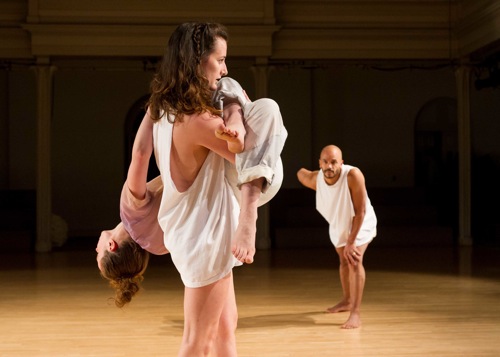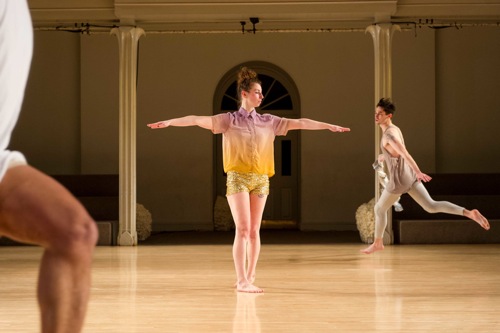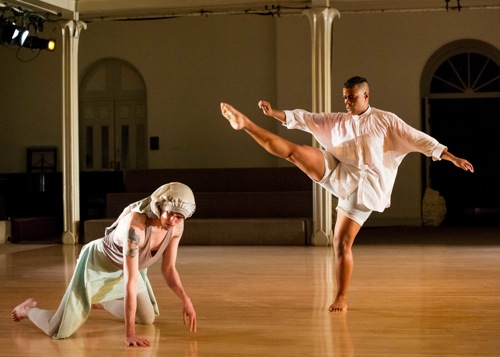Vanessa Anspaugh presents a new work at Danspace St. Marks.

Bessie McDonough-Thayer carries Eleanor Smith, Addys Gonzalez looks on in Vanessa Anspaugh’s we were an island. Photo: Ian Douglas
“No man is an island,/ Entire of itself,/ Every man is a piece of the continent,/A part of the main.” John Donne knew that in 1623 when, in bed with an undetermined illness, he wrote “Meditation XVII” of his Devotions upon Emergent Occasions. Choreographer Vanessa Anspaugh may have had something similar in mind when she titled her most recent work we were an island. The past tense could acknowledge a fact that traveling back and forth by ferry between Manhattan and Governor’s Island (where she and her cast were rehearsing) had knocked home: islands are just mountain tops poking up from one immense, partially submerged continent. (She mentioned this in a Dance Enthusiast interview (http://www.dance-enthusiast.com/features/view/Dance-Up-Close-Vanessa-Anspaugh-we-were-an-island-Danspace-Project).
Dancers rehearsing creatively, as did those working with Anspaugh on we were an island, are indeed separate but connected, and the piece teems with images of independent decisions and collaborative events. You might also say, that, despite the obvious discipline and craft, the five performers sometimes create the illusion of acting on a whim.
The audience at St. Marks Church sees this co-commission by Danspace Project and the Lower Manhattan Cultural Council from the altar steps, facing the entryway and the balcony and rose window above it. We sit in the dark for a while, listening to an overture overture of sorts—piano, percussion, a song from the depths. Then lighting designer Kathy Kaufmann makes a glare flashes on, go off, and transform into moderate sunlight. A man in a short, loose-fitting white tunic (costumes by Hayden Dunham) runs in counter-clockwise circles, his right arm stuck out to his side and parallel to the floor. This man (it is Addys Gonzalez, a powerful performer) looks at us searchingly whenever he can. Is he scoping us out? Does he wants something? He decides to run clockwise. An identically dressed woman (Bessie McDonough-Thayer) joins him. They note each other, vary their directions and tracks. The song ends. A woman who looks like a member of different species enters. She (Eleanor Smith) doesn’t run. She makes big, sweeping, dancerly movements that involve her entire body and limbs, and gradually pull her backward on a long a diagonal to a far corner.

Vanessa Anspaugh’s we were an island. Eleanor Smith spins; behind her, Jesse White runs. Addys Gonzalez’s leg at left. Photo: Ian Douglas
As we were an island develops over 50 minutes, utterly surprising moments occur without fanfare, as if each were just the next piece of flotsam drifting by. Questions bubble up in the wake of the five dancers’ actions. What are they thinking? What game are they playing now? They are an interestingly diverse bunch. They seem to have different kinds and amounts of training, and, although they act together at times, even (rarely) in unison, each embarks on pursuits shared with no one. At one point, when several of them have been removing the short pants under their tunics and almost immediately donning them again, White puts the waistband of his trousers around his head and crawls along. When runs, the two lengths of soft, pale fabric trail the way a jellyfish’s tentacles might float behind it. For a while, Acosta travels gradually and deliberately across the floor, undulating his torso and pushing his head forward and back, as laboring, with great muscular pressure, against a tide. No one else does either of these things. Nor does anyone come into the center of the space and spin and spin with arms spread the way Smith does.
Shortly after White and then Acosta enter, they draw close to each other and kiss with Acosta’s hand between their mouths; meanwhile Smith caresses one of White’s hands. Once, when White is lying on the floor, Acosta comes close to him and swings one leg over him, perhaps to avoid stepping on him, but Acosta keeps repeating this scything motion while drawing further and further away from White. He exhausts himself doing this. Who knows what sea-creature imagery is mingling with human experiences? One action that occurs several times has one person supine, legs in the air, while one of the others pumps those legs bent and straight; in one version of this, Smith bends over and places McDonough-Thayer’s feet against her cheeks, one on each side. Another time, backed up against White, she pushes her head up under his shirt and out the neckhole in front of his head. Just as quickly they abandon that idea for another, making the first flow quite naturally into the second.

Jesse White crawls, niv Acosta swings a leg. Vanessa Anspaugh’s we were an island. Photo: Ian Douglas
All five occasionally stop what they’re doing and stare up toward one area of the balcony. Often they appear to be thinking, “what’ll we do next?” I have no idea what that might be or, indeed, why they do what they do. Why does Smith decide to shuck her trousers and continue in spangly gold shorts? Or abandon her lovely composure to run in an ungainly manner, kicking out her legs in several directions? She just does, that’s all, and it seems, at the time both acceptable and slightly alarming.
How odd and interesting all this is! Bits of music appear and disappear (the program credits the unlikely combination of Daniel Higgs, Joan Armatrading, and Charles Atlas), as does a single cataclysmic burst of noise, the sounds of lapping water and running feet (ambient sound by Amber Bemak). The light changes. The space expands to include the carpeted risers and the entryway.
I get the impression that Anspaugh and her performer-collaborators have collected images related to islands—the waters that conceal common depths, their non-human populations, and the creative voyage the six of them took—polishing these images into new forms that jibe (how could they not?) with human relations and urges. Susan Mar Landau, credited as dramaturge, surely contributed to the shaping of all this. The result is an Alice-in-Wonderland world, where strange things happen as if they were perfectly reasonable to everyone but you, the visitor, and you have to accept that.
